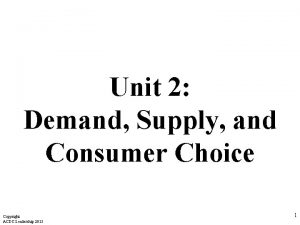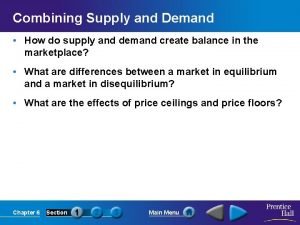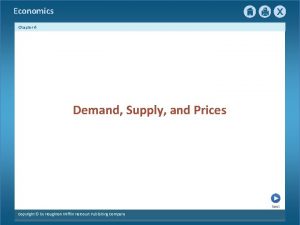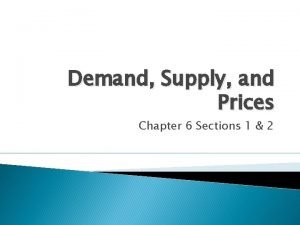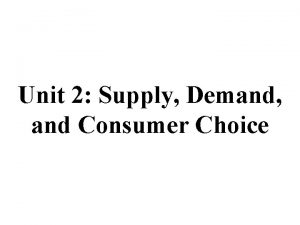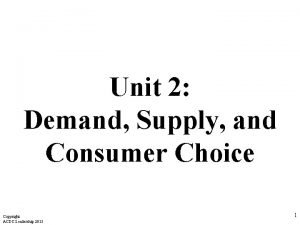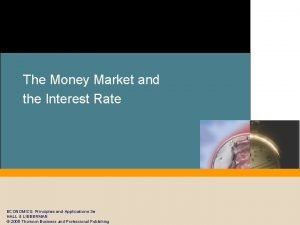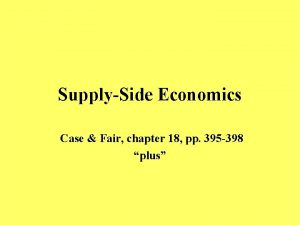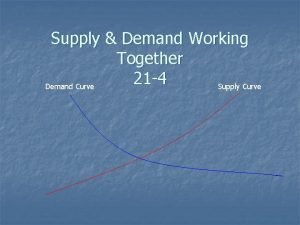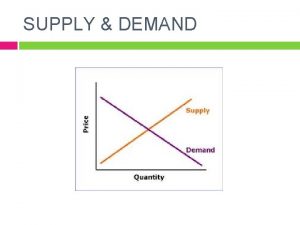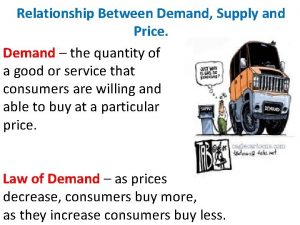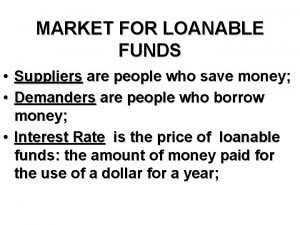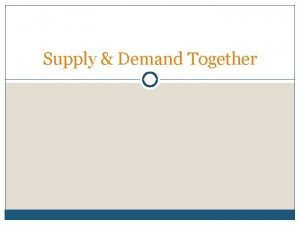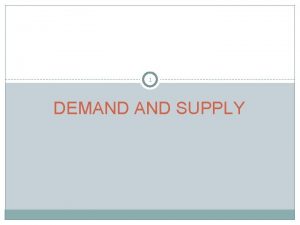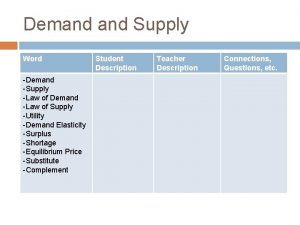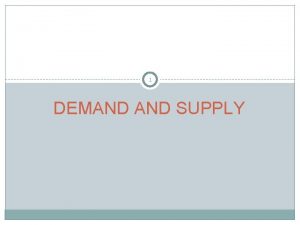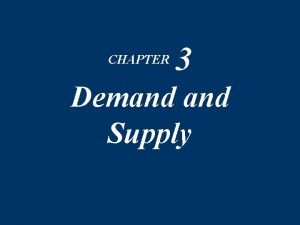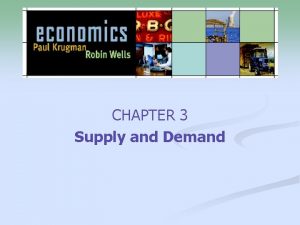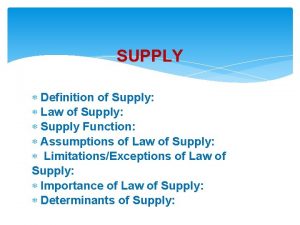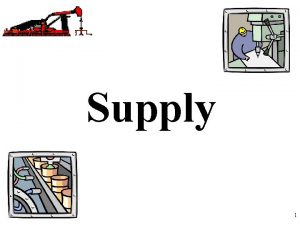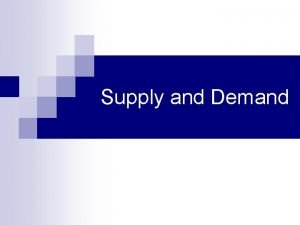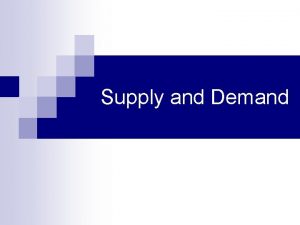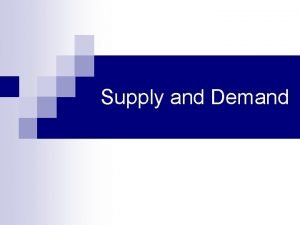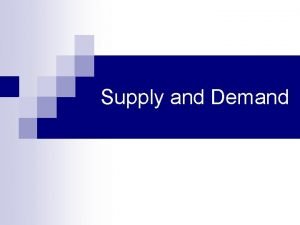TREGARTHEN CHAPTER 3 DEMAND SUPPLY Key Definitions Demand































- Slides: 31

TREGARTHEN CHAPTER 3: DEMAND SUPPLY

Key Definitions Demand schedule A table that shows the quantities of a good or service demanded at different prices during a particular period, ceteris paribus. Demand curve A graphical representation of a demand schedule Law of Demand The idea that for virtually all goods and services, people will want to consume more at lower prices than at higher prices, ceteris paribus (in other words there is an inverse relationship between price and quantity demanded)

Key Definitions (cont. ) Demand shifter A variable that can change the quantity of a good or service demanded at each price Oprah effect a demand shifter that causes people’s preferences for a good or service to change Change in quantity demanded Movement along a demand curve that results from a change in price Change in demand A shift in a demand curve, caused by a demand shifter

Demand Consumer Perspective Why do we consume a good or service? Demand is based on three key assumptions People economize People respond to incentives in predictable ways All choices involve costs

Change in Quantity Demanded Caused by a change in price of the good or service you are talking about Is illustrated by a movement ALONG the demand curve Example: If the price of falafel increases, the quantity demanded of falafel decreases.

Change in Demand Caused by a change in a demand shifter; NOT caused by a change in the price of the good or service you are talking about Illustrated by a movement OF the entire demand curve Example: A study is published that says eating falafel twice a week can add ten years to your life. Even though the price of the falafel stays the same more people would want falafel because of its health benefits. This would be illustrated by a shift to the right of the demand curve.

Change in Demand: Demand Shifters Consumer preferences Prices of related goods and services Income Demographic characteristics Buyer expectations

Change in Demand: Demand Shifters Preferences if attitudes toward a product improve, demand will shift to the right; if people develop a negative attitude toward a product, demand will shift to the left What do you think will happen for the demand for Toyotas now that Toyota has recalled several models?

Change in Demand: Demand Shifters Prices of related goods and services Complements goods that are used together Examples: softball/softball glove, snowboard/bindings Reducing the price of one, increases the demand for the other Increasing the price of one, decreases the demand for the other Remember there is an INDIRECT relationship between the price of one complement and demand for another

Change in Demand: Demand Shifters Prices of related goods and services Substitutes goods or services that are used interchangeably Examples: chocolate chip cookies/oatmeal cookies; tea and coffee Increasing the price of one, increases the demand for the other Decreasing the price of one, reduces the demand for the other Remember there is a DIRECT relationship between the price of one substitute and demand for the other

Change in Demand: Demand Shifters Income � For normal goods, an increase of income will increase demand. Examples: snowboarding vacations to Mammoth Mountain � For inferior goods, an increase of income will decrease demand. Examples: canned versus fresh fruit

Change in Demand: Demand Shifters Demographic Characteristics (number of buyers) � The greater the number of buyers, the greater the demand. � Example: Increase in birth rate in Santa Monica would ______ demand for diapers.

Change in Demand: Demand Shifters Buyer Expectations (about future prices) � An expectation of higher prices in the future, will increase demand in the present. � An expectation of lower prices in the future, will decrease demand in the present. � Example: The expectation of “black Friday” sales can reduce demand for electronics in the days prior to “black Friday. ”

Supply: Key Definitions Supply Schedule �A table that shows the quantities supplied at different prices during a particular period, ceteris paribus Supply Curve �A graphical representation of a supply schedule Change in quantity supplied � Caused by a change in price; represented by movement ALONG the supply curve Change in supply �A shift in the supply curve caused by a supply shifter

Supply Producer Perspective Anything that affects production costs will determine how much of a good or service sellers are willing to offer for sale A higher price will usually cause producers to offer a greater quantity of a good or service Need to assume that only one variable changes at a time

Change in Supply: Supply Shifters Prices of factors of production Returns from alternative activities Technology Seller expectations (about future prices/market conditions) Natural events Number of sellers

Change in Supply: Supply Shifters Prices of factors of production � An increase in a price of a factor of production, ______ supply. � Example: A requirement that restaurant owners use separate cooking equipment to prevent cross contamination would decrease the supply of food that restaurant owners could supply.

Change in Supply: Supply Shifters Returns from alternative activities � If suppliers think they can make more profit from producing another good or service, they will decrease the supply of the good or service they are currently producing.

Change in Supply: Supply Shifters Technology � Most of the time, an improvement in technology has the effect of _____ production costs and therefore shifts supply to the ____.

Change in Supply: Supply Shifters Seller Expectations (about future market conditions) � An event that leads producers to think that prices are going to go up in the future, will lead producers to reduce supply in the present.

Change in Supply: Supply Shifters Natural Events

Change in Supply: Supply Shifters Number of Sellers � As more sellers enter the market, supply shifts to the ____.

Demand, Supply, and Equilibrium Model of demand supply � Uses demand supply curves to explain the determination of price and quantity in a market Equilibrium price � The price at which the quantity demanded equals the quantity supplied Equilibrium quantity � The quantity demanded and supplied at the equilibrium price

Surplus � See graph p. 73 � A surplus is the amount by which the quantity supplied exceeds the quantity demanded at the current price (S>D) � A surplus occurs only when the current price exceeds the equilibrium price � A surplus places a _____ pressure on price. � As prices decrease, the quantity supplied decreases and the quantity demanded increase. � In general, do you think surpluses last a long time? Why or why not?

Shortage See graph p. 73 A shortage is the amount by which the quantity demanded exceeds the quantity supplied at the current price (D>S) A shortage occurs when the current price is below the equilibrium price. A shortage puts an ______ pressure on price. As prices increase, the quantity supplied increases and the quantity demanded decreases.

Shifts in Supply and Demand See graphs on p. 74 An increase in demand (when supply stays the same) � New equilibrium price and quantity is higher/more than original equilibrium. A decrease in demand (when supply stays the same) � New equilibrium price and quantity is lower/less than original equilibrium.

Shifts in Supply and Demand See graphs on p. 74 An increase in supply (when demand stays the same) � New equilibrium price will be lower and new equilibrium quantity will be higher than original equilibrium A decrease in supply (when demand stays the same) � New equilibrium price will be higher and new equilibrium quantity will be less than original equilibrium

Simultaneous Shifts (Honors Only) In order to compare the original equilibrium with the new equilibrium when both demand supply curves shift, you must know the direction of each shift and the relative amounts by which each curve has shifted.

Simultaneous Shifts See table on p. 76 Decrease in both supply and demand: decrease in equilibrium quantity, but don’t know what happens to equilibrium price Increase in both supply and demand: increase in equilibrium quantity, but don’t know what happens to equilibrium price

Simultaneous Shifts See table on p. 76 Decrease in supply and increase in demand: new equilibrium price will be higher than original, but new equilibrium quantity depends on relative amounts of supply/demand curve shifts Increase in supply and decrease in demand: new equilibrium price will be lower than original, but new equilibrium quantity depends on the relative amounts of supply/demand curve shifts

Circular Flow Model (p. 78) Provides an overview of how markets work and how they are related to each other; it shows flows of spending and income through the economy Model comprised of Product markets-markets in which firms supply goods and services to households � Households-entities that supply factors of production (esp. labor) to firms � Factor markets-markets in which households supply factors of production demanded by firms � Firms-enterprises that create goods and services demanded by households �
 Matching supply with demand
Matching supply with demand Module 5 supply and demand introduction and demand
Module 5 supply and demand introduction and demand Unit 2 demand supply and consumer choice answer key
Unit 2 demand supply and consumer choice answer key Combining supply and demand answer key
Combining supply and demand answer key Cscmp definition of supply chain management
Cscmp definition of supply chain management Dynamic discounting definition
Dynamic discounting definition Standard definitions for techniques of supply chain finance
Standard definitions for techniques of supply chain finance Chapter 5 section 1 supply
Chapter 5 section 1 supply Chapter 6 section 1 combining supply and demand answers
Chapter 6 section 1 combining supply and demand answers Chapter 6 section 2 supply and demand in everyday life
Chapter 6 section 2 supply and demand in everyday life Sras lras
Sras lras Chapter 6 demand supply and prices
Chapter 6 demand supply and prices Chapter 6 supply demand and government policies
Chapter 6 supply demand and government policies Ui integrity key definitions
Ui integrity key definitions On a wet barrel hydrant where is the valve located
On a wet barrel hydrant where is the valve located Example of business model canvas
Example of business model canvas Key partners key activities key resources
Key partners key activities key resources Chapter 4 section 2 the demand curve shifts
Chapter 4 section 2 the demand curve shifts Chapter 4 section 3 elasticity of demand answer key
Chapter 4 section 3 elasticity of demand answer key Lesson 3 elasticity of demand answer key
Lesson 3 elasticity of demand answer key Parallelism for paired ideas
Parallelism for paired ideas Chapter 13 sentence check 2 answer key
Chapter 13 sentence check 2 answer key Ratio ng elastisidad
Ratio ng elastisidad Unit 2 demand supply and consumer choice
Unit 2 demand supply and consumer choice New grilling technology cuts production time in half
New grilling technology cuts production time in half Money market supply and demand
Money market supply and demand Supply side economics vs keynesian
Supply side economics vs keynesian Combining supply and demand worksheet
Combining supply and demand worksheet Interaction of demand and supply
Interaction of demand and supply Combining supply and demand worksheet
Combining supply and demand worksheet Supply and demand of loanable funds
Supply and demand of loanable funds Loanable funds market grpah
Loanable funds market grpah


